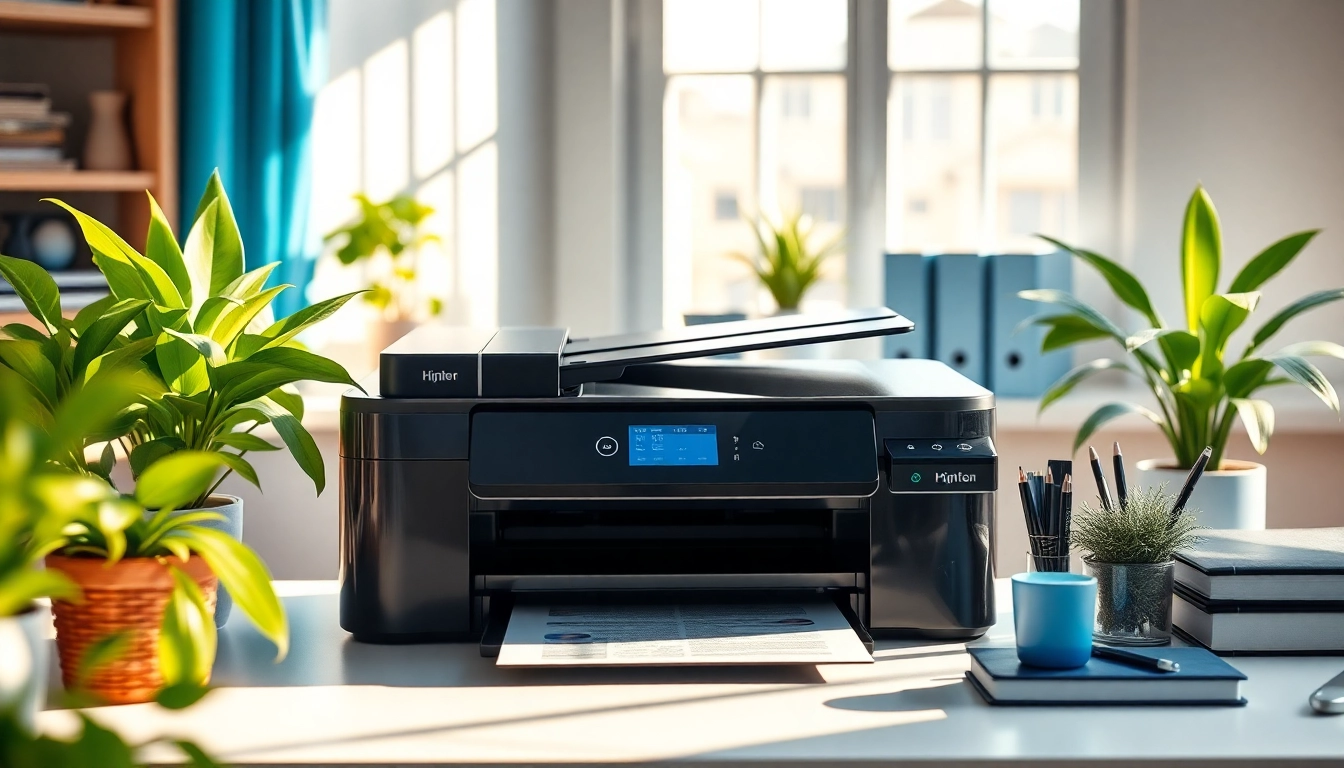Understanding Inkjet Printers
What is an Inkjet Printer?
An inkjet printer is a type of computer peripheral that produces hard copies of text documents or images by propelling tiny droplets of ink onto paper. This method allows for high-resolution color images and detailed text prints, typically reaching resolutions as high as 1200 x 1440 dpi. Inkjet printers are versatile devices found in homes, offices, and schools, serving the needs of casual users and professional graphic designers alike.
How Inkjet Printers Work: A Simple Explanation
Inkjet printing technology primarily operates through a series of ink cartridges that contain liquid ink. These cartridges are equipped with numerous microscopic nozzles that eject precise dots of ink onto paper as directed by the printer’s software. Here’s a simplified breakdown of the process:
- Data Processing: When you send a document to the printer, the computer sends data that describes how the text and images should be printed.
- Ink Ejection: The printer converts this data into a series of minute electrical signals, which, in turn, trigger the nozzles to expel ink in tiny droplets.
- Drying and Finish: The ink lands on the paper, quickly drying to create a vivid image. The printer may make multiple passes to enhance quality, especially for color documents.
This process allows for the production of high-quality promotional materials, photographs, and everyday documents with ease.
Benefits of Using an Inkjet Printer for Home Use
Choosing an inkjet printer for home use can offer numerous advantages:
- Affordability: Inkjet printers are generally cost-effective, often featuring lower initial purchase prices compared to laser printers.
- Versatility: They can handle a variety of media types, including glossy photo paper, textured stationery, and even labels, making them suitable for multiple applications.
- High-Quality Images: Inkjet printers excel at producing high-quality photo prints and vibrant color output, making them ideal for photography and graphics.
- Compact Size: Many inkjet printers are designed to be lightweight and compact, ideal for home offices with limited space.
These benefits make inkjet printers a popular choice for everyday use and specialized tasks.
Choosing the Right Inkjet Printer for Your Needs
Factors to Consider When Buying an Inkjet Printer
When shopping for an inkjet printer, there are several key factors to consider:
- Print Quality: Look for printers with high DPI ratings for photos and detailed graphics. Always review sample printouts if possible.
- Speed: Measured in pages per minute (PPM), speed is critical if you plan to print documents frequently. Evaluate your typical workload to choose appropriately.
- Operating Costs: Consider the cost of replacement ink cartridges. Some models offer more economical ink options or even bulk refill systems.
- Connectivity: Ensure the printer can connect via USB, Wi-Fi, or Bluetooth, depending on your convenience needs.
- Size: Evaluate your available space to identify a suitable model that fits your environment.
Top Inkjet Printer Brands Overview
Several brands dominate the inkjet printer market, each offering unique features and capabilities. Here are a few leading brands to consider:
- HP (Hewlett-Packard): Known for reliability and quality, HP offers a range of models tailored for both home and business use.
- Epson: Epson printers often feature advanced ink technology, including eco-friendly options and high-capacity ink tanks for cost savings.
- Canon: Canon is celebrated for its photo print capabilities and high-quality imaging technology, catering especially to photographers.
- Brother: A great choice for small offices, Brother printers offer fast printing speeds and multifunction capabilities.
Comparison: Inkjet Printers vs. Laser Printers
While inkjet printers provide versatility and vivid color output, laser printers hold advantages in speed and cost-effectiveness for monochrome printing. Consider the following comparisons:
| Feature | Inkjet Printers | Laser Printers |
|---|---|---|
| Print Quality | Excellent for photos and color documents | Superior text quality, less ideal for graphics |
| Speed | Slower, especially for color | Fast for high-volume printing |
| Cost | Initial investment lower, running costs can vary | Higher upfront cost, but cheaper per page |
| Size | Tends to be smaller and lighter | Generally bulkier due to technology |
Ultimately, your choice between an inkjet and laser printer will depend on your specific printing needs, workload, and budget.
Best Practices for Maintaining Your Inkjet Printer
Regular Maintenance Tips
To ensure your inkjet printer functions well over time, periodic maintenance is essential. Here are some best practices:
- Regular Cleaning: Run the printer’s built-in cleaning utility to prevent ink from clogging the nozzles, especially if you print infrequently.
- Keep it Covered: Dust and debris can enter the printer and cause issues. Cover your printer when not in use.
- Use Quality Paper: Always use paper specifically designed for inkjet printers to avoid jamming or uneven prints.
- Update Drivers and Software: Keeping your printer’s software current ensures optimal performance and compatibility with your computer.
How to Avoid Common Inkjet Printer Issues
To minimize problems with your printer, follow these guidelines:
- Store Cartridges Properly: If you’re not using your printer for an extended period, store ink cartridges in a cool, dark place to prevent drying.
- Regularly Print Test Pages: Printing a test page every few weeks can keep the ink flowing and prevent crusting.
- Avoid Overfilling Paper Tray: Only keep the amount of paper you need in the tray to prevent jams.
Replacing Ink Cartridges and Other Supplies
Knowing when and how to replace ink cartridges efficiently can save you time and ensure quality prints:
- Monitor Ink Levels: Keep an eye on the printer’s display or the software on your computer to anticipate when it’s time to replace cartridges.
- Purchase Quality Cartridges: Opt for original equipment manufacturer (OEM) cartridges when possible to maintain print quality and avoid compatibility issues.
- Follow Instructions: Always follow the manufacturer’s instructions for replacing cartridges to avoid damaging the printer.
Advanced Features of Inkjet Printers
Wireless Printing Capabilities: Pros and Cons
Wireless printing has become a standard feature in modern inkjet printers. Here are some advantages and drawbacks to consider:
Pros:
- Convenience: Print from any room, and multiple devices can connect without physical cords.
- Mobile Printing: Use smartphone apps to print directly from mobile devices, increasing accessibility.
Cons:
- Connectivity Issues: Wireless connections can occasionally drop or have interference, leading to frustration.
- Setup Complexity: Initial setup may require some technical knowledge to configure properly, especially with network settings.
Eco-Friendly Inkjet Printer Options
With increasing attention on environmental sustainability, many brands now offer eco-friendly inkjet printers. Look for:
- Energy-Efficient Models: Printers that consume less power can significantly reduce your electricity usage.
- Recyclable Cartridges: Some manufacturers provide options for recycling used cartridges.
- Eco-Inks: These biodegradable inks are made from renewable resources, reducing environmental impact.
Smart Features: Integrating Your Inkjet Printer with Home Tech
Integration with smart home technology enhances the user experience. Some advanced features include:
- Voice Control: Control your printer through smart assistants like Amazon Alexa or Google Assistant.
- App Integration: Many printers come with mobile apps to manage printing jobs, monitor ink levels, and adjust settings remotely.
- Cloud Printing: Print documents stored in the cloud directly from your printer without needing to connect to a computer.
Maximizing Productivity with Your Inkjet Printer
Printing Techniques for High-Quality Outputs
Achieving the best print quality from your inkjet device can involve various techniques:
- Optimal Settings: Use the highest quality setting for photos and graphics but balance this with speed for documents.
- Calibrate Your Printer: Regular calibration can help improve color accuracy and alignment.
- Paper Choice: Select the right paper type to match your print job, as even the best printer will struggle with incompatible media.
Leveraging Your Inkjet Printer for Creative Projects
Inkjet printers can be powerful tools for a variety of creative projects:
- Custom Invitations: Design and print personalized invitations and cards for events.
- Photo Projects: Create high-quality photo books, collages, or art prints to showcase your photography.
- Crafting: Print designs for scrapbooking, fabric transfers, and other DIY crafts.
Performance Metrics: Understanding Print Speed and Quality
Two critical metrics are essential to evaluate when assessing your printer’s performance:
- Print Speed: Measured in pages per minute (PPM), know the rated speeds for both black & white and color to align with your printing needs.
- Print Quality: Assess quality based on DPI, color accuracy, and detail, especially when printing images. Reviewing samples can offer valuable insights.
Understanding these metrics helps select the right inkjet printer that meets both your speed and quality expectations.







